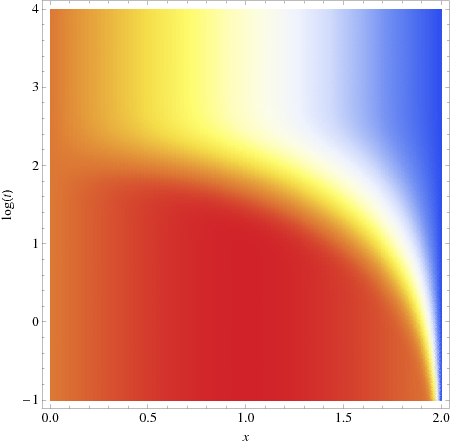5.6: Ecuaciones no homogéneas
- Page ID
- 113667
Considera una varilla de longitud\(2\) m, aislada lateralmente (el calor solo fluye dentro de la varilla). Inicialmente la temperatura\(u\) es
\[\frac{1}{k}\sin\left( \frac{\pi x}{2} \right) + 500 \text{ K}. \nonumber \]
Los extremos izquierdo y derecho están ambos unidos a un termostato, y la temperatura en el lado izquierdo se fija a una temperatura de\(500\text{ K}\) y el extremo derecho en\(100\text{ K}\). También hay un calentador unido a la varilla que agrega un calor constante de\(\sin\left( \frac{\pi x}{2}\right)\) a la varilla. La ecuación diferencial que describe esto no es homogénea
\[\begin{aligned} \dfrac{\partial}{\partial t} u &= k \dfrac{\partial^2}{\partial x^2} u + \sin\left(\frac{\pi x}{2}\right),\nonumber\\[4pt] u(0,t) &= 500,\nonumber\\[4pt] u(2,t) &= 100,\nonumber\\[4pt] u(x,0) &= \frac{1}{k}\sin\left( \frac{\pi x}{2} \right) + 500.\end{aligned} \nonumber \]
ince la inhomogeneidad es independiente del tiempo escribimos
\[u(x,t) = v(x,t) + h(x), \nonumber \]
donde\(h\) se determinará de manera que se haga\(v\) satisfacer una ecuación homogénea. Sustituyendo este formulario, encontramos
\[\dfrac{\partial}{\partial t} v = k \dfrac{\partial^2}{\partial x^2} v + k h'' + \sin\left( \frac{\pi x}{2} \right). \nonumber \]
Para hacer la ecuación para\(v\) homogéneo requerimos\[h''(x) = - \frac{1}{k}\sin\left( \frac{\pi x}{2} \right), \nonumber \]
que tiene la solución
\[h(x) = C_1 x + C_2 + \frac{4}{k\pi^2}\sin\left( \frac{\pi x}{2} \right). \nonumber \]
Al mismo tiempo dejamos\(h\) llevar las condiciones límite,\(h(0)=500\),\(h(2)=100\), y así\[h(x) = -{200} x + 500 + \frac{4}{k\pi^2}\sin\left( \frac{\pi x}{2} \right). \nonumber \] La función\(v\) satisface
\[\begin{aligned} \dfrac{\partial}{\partial t} v &= k \dfrac{\partial^2}{\partial x^2} v, \nonumber\\[4pt] v(0,t) & = v(\pi,t) = 0, \nonumber\\[4pt] v(x,0) & = u(x,0) - h(x) = {200} x.\end{aligned} \nonumber \]
Este es un problema de un tipo que hemos visto antes. Por separación de variables encontramos
\[v(x,t) = \sum_{n=1}^\infty b_n \exp (- \frac{n^2\pi^2}{4}kt) \sin \frac{n\pi}{2}x. \nonumber \]
La condición inicial da
\[\sum_{n=1}^\infty b_n \sin nx = {200} x. \nonumber \]
de la que nos encontramos
\[b_n = (-1)^{n+1} \frac{800}{n\pi}. \nonumber \]
Y por lo tanto
\[u(x,t) = -\frac{200} x + 500 + \frac{4}{\pi^2 k} \sin \left(\frac{\pi x}{2}\right) + \frac{800}{\pi} \sum_{n=1}^\infty \frac{(-1)^n}{n+1} \sin \left(\frac{\pi nx}{2}\right) e^{-k (n \pi/2)^2 t}. \label{eq.10} \]
Nota: como\(t\rightarrow \infty\),\(u(x,t) \rightarrow -\frac{400}{\pi} x + 500 + \frac{\sin \frac{\pi}{2}x}{k}\). Como puede verse en la Fig. \(\PageIndex{1}\)este enfoque es bastante rápido —hemos elegido\(k=1/500\) en esa cifra, y resumimos sobre las primeras 60 soluciones.

Figura\(\PageIndex{1}\): Dependencia temporal de la solución a la ecuación no homogénea\ ref {eq.10}.


